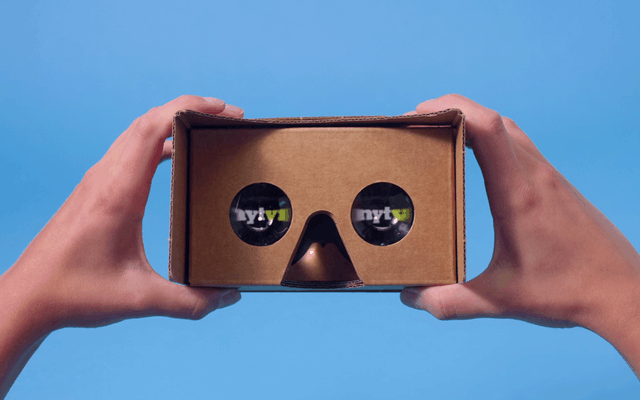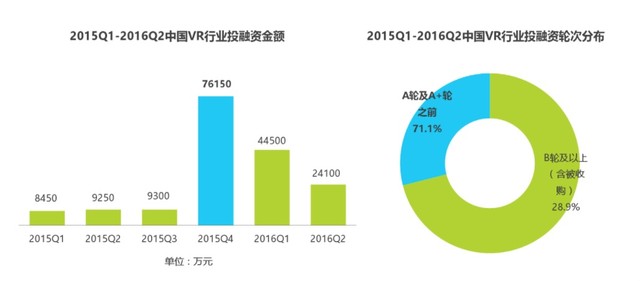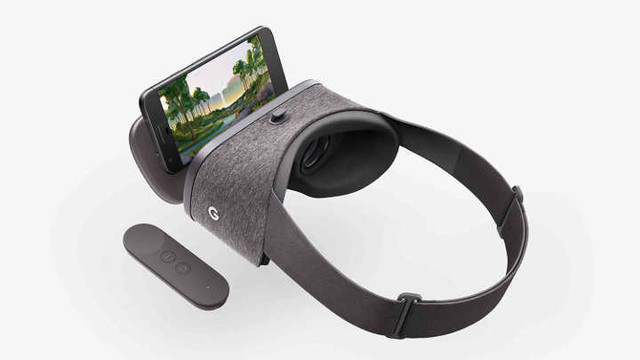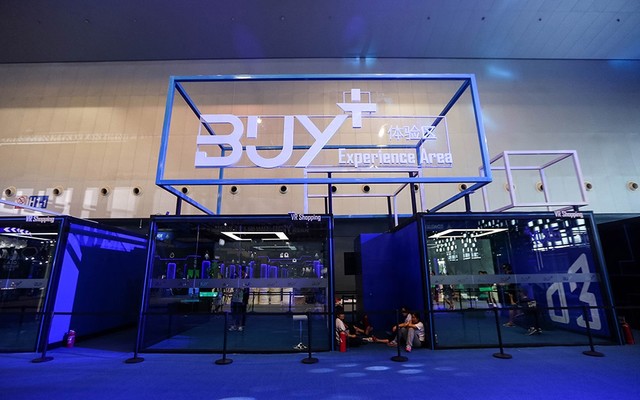At CES 2016, more than 40 booths exhibited games and virtual reality related products. In 2017, there were more than 90 VR/AR exhibitors on CES, which was a lot more than last year.
However, the fiery CES VR/AR participation does not mean that the industry has achieved brilliant results in the past year.
The VC data analysis agency CB Insights has published a report in the VR field. Data show that in the first two quarters of 2016, the volume of transactions in the VR field has dropped significantly compared to the fourth quarter of 15 years, and the volume of transactions in Q2 2016 has fallen by 38% compared to the peak time, and there has been a continuous decline. the trend of.
2016, known as the "VR first year," may have been overrated.

The VR giant loses his voice and the small producers have a lively CES
The CES VR exhibitors still took the lead, but several giants such as Oculus, Sony PS VR and HTC Vive did not launch new products. Oculus appeared on a sofa with Intel's Rift head-up display and gaming notebook. Sony also announced the sale data of the PS4 for 16 years. HTC Vive did not release its second-generation products. It just brought new accessories and will continue to promote offline layout.
In terms of AR, the Magic Leap product bounced for the spurious turmoil at the end of 2016. Meta and Microsoft HoloLens also exhibited as partners. There is no separate booth.
Although the giants did not have much movement, VR small producers were very active at CES. From mobile VR, all-in-one to AR glasses, the hardware exhibited was still dominated by the show.
For example, Bird looked at the release of the VR all-in-one Pico Neo Consumer Edition and a tracking suite. Da Peng brought a new PC helmet E3 and space positioning program E-Polaris, and 3Glasses exhibited the first generation of consumer Lan Pen S1 package and 3Wand interactive suite.
However, it can be said that the head display does not have too many surprises. On the contrary, accessories related to this industry are more worth seeing.
The giants, HTC brought Vive tracker Tracker, wireless VR upgrade kit, Vive listen to smart headband and Noitech's Hi5 gloves.

Insta360 Pro Camera
Panorama cameras are important exhibitors for accessories. Insta360 brings an 8K resolution Insta360 Pro camera designed for 360-degree VR movies for $3,000. Compared to Nokia's OZO, which has a high price of RMB 320,000, Insta360 Pro cameras are more “civilized†and may be able to better promote the production of VR content.
More interesting people, such as some VR tactile feedback shoes, also attracted some eyeballs.
CES bustle and market chilling
In 2012 and 2013, capital investment events for the VR industry were only one and four, and the investment amount was almost negligible. However, by 2014, the number of investment events and investments rose instantly to 17 and 270 million yuan.
In 2015 and the first half of 2016, the number of investment events rose to 57 and 38, respectively, and the investment amount reached 2.4 billion yuan and 1.54 billion yuan respectively. However, in the second half of 2016, few VR companies have become popular with investment institutions.
Roller coaster-like development track.
According to the report of iResearch, the number of companies in the domestic VR industry is currently around 100, but no more than 10 companies have received financing in Round B or above.

The difficulties of start-up companies, in addition to financing difficulties and profitability will take time, there are pressure from large companies. Taking the content aspect as an example, optical media, China Video, Digital Kingdom, iQIYI, Youku, and micro-whales have all entered the game. The existing resources of large companies are inherently an obstacle to the development of entrepreneurs. With their participation, IP copyright fees have also increased. At the same time, some hardware companies, or large companies that are still in the "wait and see" stage, have chosen to invest in capital, funding, or platform benefits.
With cold capital and low market demand, some companies have begun to have rumors of layoffs. The biggest impact on the industry is the storm layoffs and Mido Entertainment’s arrears.
An industry practitioner once joked: “You can earn a lot of money and live well. You may have to count the Huaqiang North as a mobile phone box manufacturer for a few bucks.†Of course, today’s manufacturers of VR boxes have had a hard time There are many inbound players, and the profit margins of products are squeezed and the money is getting less and less. The most profitable offline experience stores are not as good.
However, the 16-year VR circle is not a bad thing.
Google proposes a Daydream standard.
Daydream's launch establishes a "reference design" for mobile VR heads. It means that some of the more verbose VR hardware and software vendors will be squeezed, but on the other hand, Daydream has given mobile VR a uniform. Standard setting, hardware market is no longer uneven. But this is only the beginning. At present, the mobile VR market is still chaotic and there are few mobile phones that meet the Daydream standard.

The delivery of the three giants has also played a central role in the VR market that has been caught in the quagmire of winter. However, the specific sales of the Sony PS VR, HTC Vive and Oculus Rift are still unknown.
Afterwards, Microsoft launched Win10 VR, a general-purpose VR head-display solution. Based on this, it will have more outstanding VR heads with relatively high performance and at the same time, prices will not be too high. These products will become real consumer products.
On the content side, the VR animated film "Henry" of Oculus Story Studio won the first Emmy Award in the history of VR movies, and it is also a VR event that deserves to be remembered.
What are the possible developments in VR in 2017?
Accessories or feasibility
Judging from the CES show at the beginning of 17 years, there will be new development space for VR-related accessories this year. On the one hand, in 2016, there were many rumours that Microsoft and Oculus were all researching new VR controllers. At CES, the giant HTC Vive was not pushing new products. Instead, it took the lead in getting accessories, from wireless devices to Headphones, VR gloves; although the show is still the main show, but there have been a lot of good accessories products; the other hand, the current VR market has a lot of head-display products, but only the first experience is more limited In this environment, cut into the accessories market or have some room for development.
IResearch has published a report on 16 years of VR industry. The report mentioned that currently there are about 3,500 products on the domestic VR platform, and the mobile-phone-based mobile boxes lack interactive features. The content is mainly based on ornamental videos and pictures. With the increase of VR accessories and the standardization of mobile VR, 2017 may also be a good time for content creation.
Profitable chip makers
In addition to accessories, rushing to benefit from the VR tide, there are still unknown chip makers.
Both VR/AR heads need to be used with strong computing power. For clear computing power and game content display, chip makers and graphic vendors have more say.
At a VR-related conference in 2016, Intel’s Technical Sales Director Gao Yu stated that Intel can provide high-performance CPUs and GPUs at the same time, which is one of its advantages in the VR field because only CPU and GPU performance is sufficient. Powerful to give users the best immersive experience.
At CES 2017, Intel, NVIDIA, AMD and Qualcomm all brought new chip processors. Ai Fan children's article "Virtual / Augmented Reality behind the hot, more like a chip maker war", has mentioned how chip manufacturers in the VR boom layout.
With the rise of mobile smart devices, the PC market has been declining, but new demands have emerged. New areas such as artificial intelligence and virtual reality have brought new opportunities for chip makers. Nvidia also stated at 2017 CES that Nvidia’s share price rose by 230% in 2016 and its net profit reached US$1.2 billion.
Vertical Field: VR + Scene
The landing of virtual reality technology is to provide different use values ​​in different fields. In 2016, VR+ has achieved some success in real estate, live broadcasting, games, tourism, and marketing.
At 16 years, VR games have a lot of content. According to statistics from iResearch, there are currently at least 3,500 VR games; along with the demands of the first year of live broadcasting, many companies are also trying VR live broadcasting, but due to signals Problems such as transmission and bandwidth costs are not yet explosive. Alibaba is trying out on VR shopping. Buy+ has attracted a lot of attention when it was first launched. In terms of real estate and tourism, the current content is focused on viewing panoramic video and other aspects.

With the further development of VR in 17 years, the application of VR in the vertical field will be more in-depth, or will no longer be merely providing simple viewing, entertainment, and advertising functions, but will also assume more functions in medical and industrial industries.
AR's sound in the industry seems to be louder. For example, last year Microsoft provided 24,000 HoloLens to world-renowned elevator manufacturer ThyssenKrupp. These devices will be used to help the company's technical staff more efficiently deal with issues related to elevator installation and maintenance. Engineers at Volvo in Sweden have also used HoloLens to interact with virtual components. The research and development of AR by domestic manufacturers has also provided technical assistance for many companies.
Although the form of investment in the second quarter of this year is not optimistic, CB Insights is still bullish on this year's AR investment transaction, and is expected to have a 40% increase.
One machine and mobile VR
In 2016, Shenzhen Huaqiang North's one-box machine and mobile phone box battle, the one machine was defeated. Although these two products are currently unable to provide excellent VR experience as well, due to the price of the all-in-one machine is higher than that of the mobile phone box, the all-in-one machine is in a development dilemma under the price war.
Compared with the mobile phone box, the all-in-one machine has independent computing units. More interactions may have obvious advantages. Although the experience provided by the all-in-one machine has not yet reached the level where people can completely distinguish it from the VR box. Open standards, which are related to hardware performance, lack of content and so on.
At the same time, the giant has also started an all-in-one machine in 16 years, such as Intel Alloy and Oculus One Machine Santa Cruz.
In general, the mobile phone box can not meet more experience requirements, and PC VR has high requirements for the experience environment. The number of potential users owned by the all-in-one machine is actually quite small. Of course, the premise is that the hardware performance can keep up, and the all-in-one machine can get rid of the curse that is not as good as the mobile phone box.
Although the bombing incident had a significant impact on Samsung, Samsung Gear VR is still the main force in mobile VR. Mobile VR is an important product for the popularization of virtual reality. It is very important for the VR market that is still in the early stages of development. Of course, this market does not require the proliferation of mobile VR products.
After the calm, death or opportunity?
Since Facebook spent $3 billion in 2014 (the price that burst in 2014 was $2 billion) and acquired Oculus, the demand for virtual reality has increased. Those who have already fought in this industry have repeatedly stressed that "VR is the future," and some people have begun to develop other businesses after the development of bottlenecks. They also choose to sell equipment due to poor management and leave the industry.
In May 2016, the China Securities Regulatory Commission (CSRC) called for an increase in the number of VR industries. After that, Mido Entertainment’s arrears and the storm layoffs all seemed to push the VR out of the fiery scene for 16 years. , tend to be calm.
In the early years of 17 years, there was new news that Envelop VR, which is doing research and development of virtual reality multi-task operating software abroad, went out of business.
The VR/AR investment trend report released by CB Insights, a data analysis organization, shows that although 16 years of VR investment declined in the first two quarters, the transaction volume increased by nearly 42% compared to the same period of last year, and the transaction volume increased. 90%.
CB Insights believes that, although overall, the VR market is still in an early growth period, although development has not been as rapid as it was in the previous year, according to current trends, there is still room for growth in the volume of VR transactions.
Recently, when Zuckerberg appeared in the lawsuit against Oculus of ZeniMax, he mentioned that at present, VR is not as mature as he originally thought. Really good VR products may take 5 to 10 years to appear.
Some related people also stated that it is a good thing for the market to pay less attention to this industry, so that practitioners can sink more and more calmly and do early work.
Water Purifier Pressure Sensor
Water Purifier Pressure Sensor,Water Pressure Switch,Water Pressure Transmitter,Water Purifier Parts
Shenzhen Ever-smart Sensor Technology Co., LTD , https://www.fluhandy.com